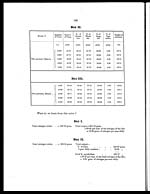Medicine - Institutions > Army health reports and medical documents > Scientific memoirs by officers of the Medical and Sanitary Departments of the Government of India > Number 37 - Investigations on Bengal jail dietaries > Part I > Chapter II - Nutritive value of Bengal jail dietaries
(159) Page 149
Download files
Individual page:
Thumbnail gallery: Grid view | List view

149
Diet III.
| Total nitrogen intake | =367.80 grms. | Total output— | |||||||
| N. of urine | 189.40 | grms. | |||||||
| .5 grm. daily constant | 12.50 | „ | |||||||
| Total N. metabolism | 201.90 | „ | |||||||
| =54.89 per cent. of the nitrogen of the diet. =8.08 grms. of nitrogen per man daily. |
|||||||||
Therefore, we obtain the following information :—
| Constants. | Varying amounts of mung dal . |
Grms. of nitrogenous metabolism per man daily. |
|||||||||
| Burma rice | 12 | ozs, | + | Mung | dal | 6 | ozs. | Diet I. | 10.05 | ||
| Wheat ata | 10 | „ | „ | „ | 5 | „ | Diet II. | 9.09 | |||
| Vegetables | 6 | „ | „ | „ | 4 | „ | Diet III. | 8.08 | |||
Again showing that the maximum absorption is obtained from a diet consisting of
12 ozs. Burma rice, 10 ozs. wheat ata, 6 ozs. vegetables when 6 ozs. of mung dal is
given, and that a reduction of the amount of dal is followed by a corresponding
reduction in the quantity of nitrogen absorbed. We give on Chart XIII the figures
for the varying amounts of mung and arhar dals plotted out to show the effects
graphically.
By working out the percentage protein absorption of mung dal from the diets
given on Table XXI it will be found to average 85 per cent.—a much higher figure
than can be obtained when the quantities of rice in the diet are greater than 12 ozs.
per man daily.
As we have already pointed out this may not be entirely due to a high protein
absorption from the dal alone—although in this particular type of diet it probably
is. In all likelihood an increased absorption takes place from the constants of the
diets so that a seemingly greater increase occurs from the varying constituents
than is really the case; this is particularly the case when we are dealing with
a bulky material like rice as the varying constituent of the diet.
This finishes all we have to say regarding section (3) or the effects of varying
the quantities of the components of the Behari type of diet.
It will be evident from a comparison of these results with those obtained from
the dietaries of lower Bengal jails that the Behari is on a higher level of nitrogen-
ous metabolism, and in accordance with this we find his physical development,
body weight, and general capabilities of performing work and resisting infection also
on a higher level. The great defect of the Behar jail diet is the same as that of the
lower Bengal diet—the large residue left over to be dealt with by the bowel with
all its attendant disabilities. It is not therefore to be wondered at that intestinal
troubles are very prevalent amongst the Beharis as well as amongst the Bengalis and
Ooriyas.
Set display mode to: Large image | Zoom image | Transcription
Images and transcriptions on this page, including medium image downloads, may be used under the Creative Commons Attribution 4.0 International Licence unless otherwise stated. ![]()
| Permanent URL | https://digital.nls.uk/75033192 |
|---|




